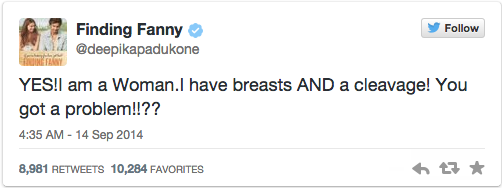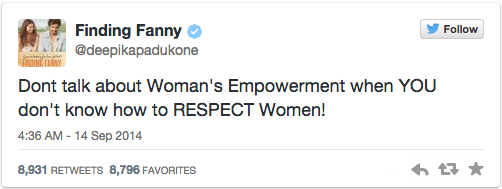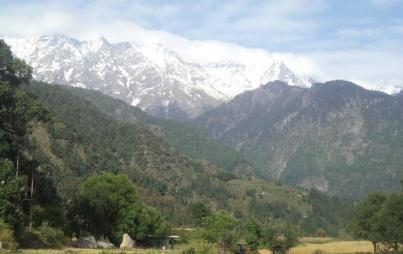
Credit: Facebook
Celebrity, cleavage, sexism, boundaries, Twitter wars . . . perhaps the great global themes of our modern era. In recent weeks, the U.S. has been grappling with these issues in the wake of the great celebrity nude photo leak of 2014. But America is not alone in this grappling.
Take for instance, what's brewing in India right now; it's quite the media war. At the intersection? Dear Deepika Padukone—one of Bollywood's top heroines, who had no fewer than three hit movies in 2013 alone. And who kicked off this hurricane of controversy? Why none other than India's leading newspaper, the Times of India—ie, the world's largest English-language daily paper.
How It All Started
The Times of India decided to tweet a "top angle" (read: chest-region-focused) shot of Deepika with a link to an online gallery and caption it "OMG: Deepika's cleavage show!" to its 2.55 million followers.
This did not go over well with Deepika, who fired back with a few pungent tweets of her own:


And she wasn't done there. She continued to slam the Times of India itself. Taking a screenshot of the TOI's tweet, she fired back:

Deepika's instant slamming of the newspaper won her widespread support—from fans and fellow actors and actresses alike. Huge names like Ranveer Singh, Priyanka Chopra, Arjun Kapoor, Jacqueline Fernandez, Huma Qureshi, Rahul Bose and Aditi Rao Hydari, among countless others, rallied around the actress.
Bollywood producer-director Karan Johar was “appalled . . . shocked and disgusted at the level of disrespect shown . . . Deepika or any women in the world cannot and should not stand for this!!”
Naturally, in light of all this outrage, the TOI had to do something. And they did.
The Times Of India Responds . . .
Deepika Padukone's anger—and, no doubt, that of her thousands of fans rallying around her—prompted the Times of India to retract its photo and tweet. This would be a positive step except . . . they also tweeted this:
“@deepikapadukone, It's a compliment! You look so great that we want to make sure everyone knew! :)”
Then the TOI went a step further by publishing a piece calling out a double standard, in this era of "women's emancipation," of journalists being free to write about the six-pack abs and chiseled bodies of actors, but not about the cleavage of an actress:
"We don't go into a hostile frenzy when cameras caress and capture SRK's and Hrithik's perfect six-pack abs. We marvel, we envy and we drool. Why should it be different for a woman?"
The TOI also observed that actresses intentionally flaunt their beauty in front of cameras in order to be photographed and commented on, thus it is silly for actresses to say, "Why did you notice and focus on what I flaunted?"
What To Make Of It All?
So what does one make of this ever-snowballing discussion? Deepika Padukone in the tweeted photo is seen wearing a deep-neck Anarkali dress, which is, of course, not at all offensive. That said, the camera angle of the particular photo does sleazily focus on her cleavage. Two main questions arise from this and the controversy in its wake: Has TOI really crossed the line? And has Deepika overreacted?
I would say yes to both. Newspapers and media constantly cross boundaries when it comes to covering celebrities and as a result, do sometimes get slammed and even sued. Their only objective, in this modern age of media, is to entice readers with their juicy pictures and words. Deepika’s words remind them that despite this objective, it is never OK to focus on the body parts of actors and actresses as if they are objects.
That said, Deepika, as a wildly famous actress, is by no means new to body exposure or publicity through photos and comments. She could have protested in a more measured way. The film industry and everyone rallying to her support? It gives this whole affair a lot of color—everyone wants to jump in. Hence the speculation that this could be a publicity stunt by Deepika to get some attention for her latest movie Finding Fanny.
What ultimately remains clear? The murkiness of questions surrounding celebrity, boundaries and media—and their very global nature.






